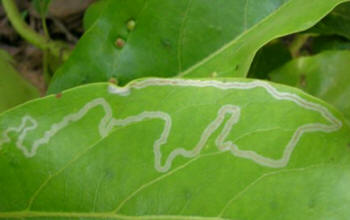Leaf Miners - descriptively named because of their 'mining' action in leaves - are the larvae of several different types of moths, flies etc. The Leaf Miner larvae dig themselves into the very heart of the leaf, between the top and bottom layers, and then burrow along inside having a nice meal, and leaving a rather unsightly 'trail' behind them. Sometimes known as Leafminers.
They are particularly troublesome on some plants - Chrysanthemums, Nasturtiums, Hollies, Cinerarias, Gerberas and Pyrethrums to name the most affected.
As the little bug is well and truly inside the leaf, spraying is not normally the best option. If you have a bad infestation, then spray with a systemic insecticide or Malathion. (NOTE Malathion cannot be used on certain plants!) Imidacloprid is a good spray to use at the start of an infection. It is marketed in UK under name of Provado.
 If
there are just a few affected plants, then the leaves can be picked
off and destroyed. If you hold an infected leaf up to the light, then
you may see the larvae inside its tunnel. There can be a certain
degree of satisfaction to be had by squashing the little pests. It can
become addictive!
If
there are just a few affected plants, then the leaves can be picked
off and destroyed. If you hold an infected leaf up to the light, then
you may see the larvae inside its tunnel. There can be a certain
degree of satisfaction to be had by squashing the little pests. It can
become addictive!
Companion plants can also be planted nearby - Columbines attract Leaf Miner parents, and the inner of the leaf is a good food source for the Leaf Miner Larvae.
Leafminers that attack Azaleas, have a different method of 'tunneling. Instead of the long winding burrow associated with the Chrysanthemum leaf miner, the Azalea Leaf miner tends to chew away in a more localised areas - leading to large 'blisters' or blotches rather than tunnels.
Main Page for Apple Tree Problems